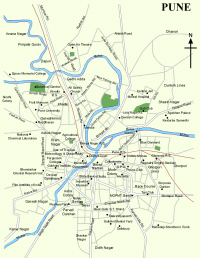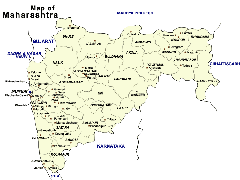In and around Pune
| Eastern Area | Central Area | Southern Area | Western Area | Outside Pune | Map of Pune |
EASTERN AREA
Aga Khan Palace
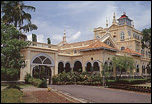 True
to its name this place boasts of Italianate arches and spacious lawns,
an unlikely place for a prison but the Britishers interned Mahatma
Gandhi and his wife Kasturba Gandhi here.The architecture of the palace
wil take you down memory lane, reminding you of the illustrations from
fairy tale houses.
True
to its name this place boasts of Italianate arches and spacious lawns,
an unlikely place for a prison but the Britishers interned Mahatma
Gandhi and his wife Kasturba Gandhi here.The architecture of the palace
wil take you down memory lane, reminding you of the illustrations from
fairy tale houses.
Shindyanchi Chhatri
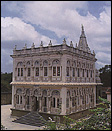 Amongst
the architectural prides of Pune, the memorial to the great warrior
Mahadji Shinde, the commander-in-chief of the Maratha army, between the
years 1760 to 1780 under the mighty Peshwas. The temple adorned with
Rajasthani architecture is an imposing edifice situated at Wanowrie.
Amongst
the architectural prides of Pune, the memorial to the great warrior
Mahadji Shinde, the commander-in-chief of the Maratha army, between the
years 1760 to 1780 under the mighty Peshwas. The temple adorned with
Rajasthani architecture is an imposing edifice situated at Wanowrie.
Lal Deval (Synagogue)
Lal Deval is conspicuously placed on Moledina Road. The
red-brick-and-stone structure built in the English Gothic style,
resembles a church. It is Pune's finest synagogue, built by
philanthropist David Sassoon in 1867.
The Osho International Commune
The Osho International Commune
is in Koregaon Park, attracting thousands of foreigners wishing to take
part in the meditation courses organized by the Ashram. The Commune was
founded by Osho Rajneesh who died in 1990. His samadhi is situated in
the Ashram. The commune has beautiful gardens open to the public in the
mornings and evenings.
CENTRAL AREA
Pataleshwar Cave Temples
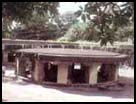 Just across the river on the Jungli Maharaj Road is a wonderful pataleshwar temple
(Panchaleshvara cave), a small 8th century temple similar in style to the much grander
rock temple at Elephanta but never completed. More importantly it's an active temple.
In front of the excavation is a circular Nandi mandapam (pavilion). Adjacent to Jungli
Maharaj (Lord of the Jungle) temple, dedicated to a Hindu ascetic who died here in 1818.
Just across the river on the Jungli Maharaj Road is a wonderful pataleshwar temple
(Panchaleshvara cave), a small 8th century temple similar in style to the much grander
rock temple at Elephanta but never completed. More importantly it's an active temple.
In front of the excavation is a circular Nandi mandapam (pavilion). Adjacent to Jungli
Maharaj (Lord of the Jungle) temple, dedicated to a Hindu ascetic who died here in 1818.
Kesari Wada
The home of the Kesari newspaper started by Late Lokmanya Bal
Gangadhar Tilak. It was from this very place that the candle for Self
Rule was lit. Also worth seeing is the first Indian National flag
unfurled by Madam Cama, and many other documents which are well
preserved here.
Shaniwar Wada
 The
historic palace of the Peshwa (Prime Ministers) rulers, became the seat
of political power during Bajirao-I's reign and became so conspicuous
that to this date the palace has become the symbol of the city and its
culture. Built in 1736, the Shaniwar Wada was once the palace of the
great Peshwa rulers. The wada (Fort) was destroyed by a major fire in
1827, the cause of the fire till today remains a mystery.
The
historic palace of the Peshwa (Prime Ministers) rulers, became the seat
of political power during Bajirao-I's reign and became so conspicuous
that to this date the palace has become the symbol of the city and its
culture. Built in 1736, the Shaniwar Wada was once the palace of the
great Peshwa rulers. The wada (Fort) was destroyed by a major fire in
1827, the cause of the fire till today remains a mystery.
Museum of Arthropoda
If it's the wonders of nature that you are interested in, then you must
visit this museum of Natural History. Their specific focus is on the
joint legged animals. These creatures are always on the move - for
they're all legs. This museum has most of the multi- legged varieties -
lobsters, prawns, crabs, worms, beetles and cockroaches too.
Parvati Hill and Temples
 The
'Nagarkhana' drum house, the imposing temple of Parvati and
Devdeveshwar are the main structures on the hill. The Parvati museum
houses protraits of heroes of the Peshwa dynasty, besides old
manuscripts, weapons and coins. A group of beautiful temples of
Ganapati and Kartikeya make Parvati add to Parvati's attractions.
According to the records, the main idol was carved out of gold by
craftsmen from Karnataka. After this was stolen in 1932, it was
replaced by silver idols plated with gold. The 108 step climb to the
17th century temple located on top, the hill is also the favourite
haunt of fitness fans.
The
'Nagarkhana' drum house, the imposing temple of Parvati and
Devdeveshwar are the main structures on the hill. The Parvati museum
houses protraits of heroes of the Peshwa dynasty, besides old
manuscripts, weapons and coins. A group of beautiful temples of
Ganapati and Kartikeya make Parvati add to Parvati's attractions.
According to the records, the main idol was carved out of gold by
craftsmen from Karnataka. After this was stolen in 1932, it was
replaced by silver idols plated with gold. The 108 step climb to the
17th century temple located on top, the hill is also the favourite
haunt of fitness fans.
Khunya Murlidhar Temple
A famous merchant of the Peshwa
regime, Dada Gadre had this temple built in 1797, in Sadashiv Peth. The
marble idol of Radhakrishna was made by a Rajasthani sculptor named
Barwatram. There are a couple of theories about the unusual name
'Khunya Murlidhar' (roughly translated as Killer Murlidhar). One says
that during the installation of the idol, the Arab and English guards
were engaged in a bloody battle. Hence this name. The other theory
harks back to mythology blaming Sri Krishna for his advice to Arjuna
which led to the grand battle of Mahabharata and killed all his
opponents thereby creating widespread bloodshed.
Omkareshwar Temple
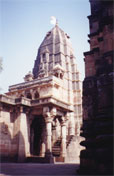 Omkareshwar Temple was constructed during the tenure of Sadashivrao
Bhau on the banks of the Mutha river. This important shrine
dedicated to Lord Mahadeva (Shiva) was built by Krsnaji Panta Citrava between
1740 and 1760, by money raised from public donations. It is said that Sadashivrao
Bhau, a cousin of Nana Saheb Pehswa donated Rs. 1,000/- every month till the
work was completed. At the entrance is an imposing gateway built in Saracenic
style, which leads to a large paved courtyard. In the centre of the complex is
the main shrine of Omkareshwara and facing it is a small shrine with a giant
statue of Nandi. The adjoining river bed can be approached by two flights of
steps or ghats, one from the main temple and other from outside. During heavy
rains the water of the river enters the courtyard and shrine.
Omkareshwar Temple was constructed during the tenure of Sadashivrao
Bhau on the banks of the Mutha river. This important shrine
dedicated to Lord Mahadeva (Shiva) was built by Krsnaji Panta Citrava between
1740 and 1760, by money raised from public donations. It is said that Sadashivrao
Bhau, a cousin of Nana Saheb Pehswa donated Rs. 1,000/- every month till the
work was completed. At the entrance is an imposing gateway built in Saracenic
style, which leads to a large paved courtyard. In the centre of the complex is
the main shrine of Omkareshwara and facing it is a small shrine with a giant
statue of Nandi. The adjoining river bed can be approached by two flights of
steps or ghats, one from the main temple and other from outside. During heavy
rains the water of the river enters the courtyard and shrine.
The Beilbaug Temple
The Beilbaug Temple has idols of
Laxminarayan, Shiva and Ganapati and was built during Nana Phadnavis'
tenure at Budhwar Peth. During Madhavrao Peshwa's regime, Nana
Phadnavis also constructed his Nana Wada near the more imposing
Shaniwar Wada.
Tulsi Baug
Tulsi Baug came to be built during the time of Balaji Vishwanath. Basil
(Tulsi) gardens alongside Shiva and Ganapati temples lie here.
Vishrambaug Wada
Vishrambaug Wada was a three storied mansion of the Peshwas. It is
remarkable for its beautiful entrance and wooden carvings. Located in
the heart of the city is the Kirti Mandir - a museum of historical
glory with antique material.
Raja Dinkar Kelkar Museum
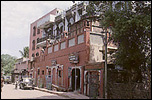 Raja
Dinkar Kelkar Museum is housed in a quaint Rajasthani-style building.
It holds a one-man collection of the most fascinating Indian artifacts.
Thirty-six sections of this museum are used to display a plethora of
antiques, carved palace doors, pottery, a priceless collection of lamps
and musical instruments of the Mughal and Maratha periods. A
masterpiece is the 'Mastani Mahal' brought and erected as it was from
its original place!
Raja
Dinkar Kelkar Museum is housed in a quaint Rajasthani-style building.
It holds a one-man collection of the most fascinating Indian artifacts.
Thirty-six sections of this museum are used to display a plethora of
antiques, carved palace doors, pottery, a priceless collection of lamps
and musical instruments of the Mughal and Maratha periods. A
masterpiece is the 'Mastani Mahal' brought and erected as it was from
its original place!
Bal Gandharv Mandir
 The
home of Marathi Theatre, both commercial and experimental. Throughout
the year there are different cultural happenings like exhibitions,
theatre, orchestra - instrumental and vocal,...
The
home of Marathi Theatre, both commercial and experimental. Throughout
the year there are different cultural happenings like exhibitions,
theatre, orchestra - instrumental and vocal,...
Tilak Smarak Mandir
Tilak Smarak Mandir on Tilak Road is a building commemorating the great
freedom fighter and social reformer Lokmanya Tilak. On the ground floor
is a small museum describing Tilak's public life and a theatre on the
upper floors.
SOUTHERN AREA
Saras Baug
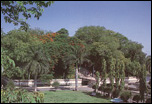 Sitting like a flat oyster towards one end of the city, the sunken
Sarasbaug is a place where hundreds of Puneites throng every evening,
for their share of fresh air among green surroundings. Adjoining
Sarasbaug, across a small narrow road is another garden. This however,
is not merely a park but a zoo as well.
Sitting like a flat oyster towards one end of the city, the sunken
Sarasbaug is a place where hundreds of Puneites throng every evening,
for their share of fresh air among green surroundings. Adjoining
Sarasbaug, across a small narrow road is another garden. This however,
is not merely a park but a zoo as well.
Peshwe Park
 Peshwe Park is situated
near Saras Baug, is a zoo maintained by the Pune Municipal Corporation
housing a variety of beautiful species of wild animals. A toy-train
ride, an elephant ride and boating are special attractions.
Peshwe Park is situated
near Saras Baug, is a zoo maintained by the Pune Municipal Corporation
housing a variety of beautiful species of wild animals. A toy-train
ride, an elephant ride and boating are special attractions.
The Katraj Snake Park The Katraj Snake Park has a collection of reptiles, birds and turtles. Naturalists would delight in the Park's exhibits and activities. The park has also recently added a zoo.
WESTERN AREA
The Film and Television Institute of India
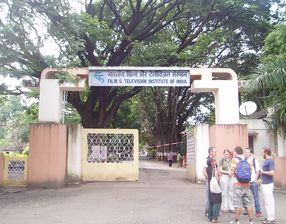 The Film and
Television Institute of India is situated on Law College Road. It
imparts training in all branches of the film and television industry
and is known for having produced some of the finest show-business
professionals in the country.
The Film and
Television Institute of India is situated on Law College Road. It
imparts training in all branches of the film and television industry
and is known for having produced some of the finest show-business
professionals in the country.
University Buildings
 The
University Buildings of the University of Pune at Ganeshkhind, once
comprised the official residence of the Governor of Bombay Presidency
during the fierce annual monsoons of the coasts. A large building in
the Italian Gothic style, it has a 30 m high square tower, a swimming
pool and manicured lawns.
The
University Buildings of the University of Pune at Ganeshkhind, once
comprised the official residence of the Governor of Bombay Presidency
during the fierce annual monsoons of the coasts. A large building in
the Italian Gothic style, it has a 30 m high square tower, a swimming
pool and manicured lawns.
Chaturshringi Temple
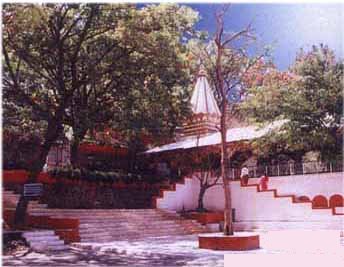 The Chaturshringi Temple is situated on a hillock off Senapati Bapat Road.
This temple is dedicated to Goddess "Durga". The Presiding deity is Goddess "Ambreshwari".
An annual nine day Navaratri festival is held here in the month of "Ashwin" (October by
the Gregorian Calender) attracted by droves of devotees. It was built in Shivaji's era.
The Chaturshringi Temple is situated on a hillock off Senapati Bapat Road.
This temple is dedicated to Goddess "Durga". The Presiding deity is Goddess "Ambreshwari".
An annual nine day Navaratri festival is held here in the month of "Ashwin" (October by
the Gregorian Calender) attracted by droves of devotees. It was built in Shivaji's era.
Pashan Lake
 Pashan
Lake nestles 12 km away from the main city off the road to the National
Defence Academy. It is the favourite stopover of a number of migratory
birds and is home to several residential birds --an ornithologically
interesting spot.
Pashan
Lake nestles 12 km away from the main city off the road to the National
Defence Academy. It is the favourite stopover of a number of migratory
birds and is home to several residential birds --an ornithologically
interesting spot.
Places of Interest outside Pune
 Ajanta Caves a UNESCO world heritage site, is famous for its Buddhist rock-cut cave
temples and monasteries with their extraordinary wall paintings. The
temples are hollowed out of granite cliffs on the inner side of a 20-meter
ravine in the Wagurna River valley, 105 km northeast of Aurangabad, at a
site of great scenic beauty. About 30 caves were excavated between the 1st
century BCE and the 7th century CE and are of two types, caityas
('sanctuaries') and viharas ('monasteries'). Although the sculpture,
particularly the rich ornamentation of the caitya pillars, is noteworthy,
it is the fresco-type paintings that are the chief interest of Ajanta.
These paintings depict colorful Buddhist legends and divinities with an
exuberance and vitality that is unsurpassed in Indian art.
Ajanta Caves a UNESCO world heritage site, is famous for its Buddhist rock-cut cave
temples and monasteries with their extraordinary wall paintings. The
temples are hollowed out of granite cliffs on the inner side of a 20-meter
ravine in the Wagurna River valley, 105 km northeast of Aurangabad, at a
site of great scenic beauty. About 30 caves were excavated between the 1st
century BCE and the 7th century CE and are of two types, caityas
('sanctuaries') and viharas ('monasteries'). Although the sculpture,
particularly the rich ornamentation of the caitya pillars, is noteworthy,
it is the fresco-type paintings that are the chief interest of Ajanta.
These paintings depict colorful Buddhist legends and divinities with an
exuberance and vitality that is unsurpassed in Indian art.
Elephanta Caves
 The
Elephanta Caves are a great tourist attraction in the vicinity of the
large Mumbai meteropolis. The Elephanta island is located 10 km away from
the Gateway of India at Mumbai. These caves house rock cut temples dating
back to the 5th century CE.The Elephanta island was so named by the
Portuguese, after the statue of an elephant near the landing area of the
island. These rock cut temples dedicated to Shiva Mahadeva are rich in
sculptural content. Motorboats take passengers from Appollo Bunder near
the Gateway of India.
The
Elephanta Caves are a great tourist attraction in the vicinity of the
large Mumbai meteropolis. The Elephanta island is located 10 km away from
the Gateway of India at Mumbai. These caves house rock cut temples dating
back to the 5th century CE.The Elephanta island was so named by the
Portuguese, after the statue of an elephant near the landing area of the
island. These rock cut temples dedicated to Shiva Mahadeva are rich in
sculptural content. Motorboats take passengers from Appollo Bunder near
the Gateway of India.
Gateway of India
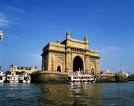
The Gateway of India is a monument in Mumbai, India. Located on the waterfront in South Mumbai, the Gateway is a basalt arch 26 metres high. The Gateway is traditionally the first thing visitors arriving by boat would see of Mumbai. Behind the Gateway steps lead down to the waterfront, where boat trips can be had to locations such as Elephanta Island.
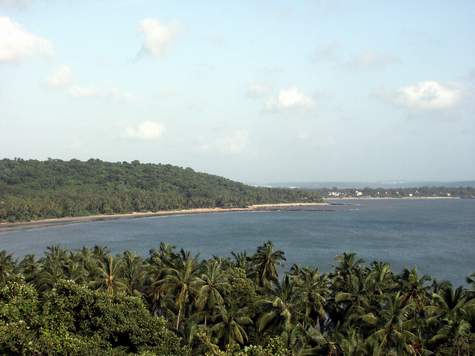 Variously known as "Pearl of the Orient" and a "Tourist Paradise", the state of Goa
is located 495 km south-west of Pune on the western coast of India in the coastal
belt known as Konkan. It is well connected to Pune by rail and road. The
magnificent scenic beauty and the architectural splendours of its temples, churches
and old houses have made Goa a firm favourite with travellers around the world.
Variously known as "Pearl of the Orient" and a "Tourist Paradise", the state of Goa
is located 495 km south-west of Pune on the western coast of India in the coastal
belt known as Konkan. It is well connected to Pune by rail and road. The
magnificent scenic beauty and the architectural splendours of its temples, churches
and old houses have made Goa a firm favourite with travellers around the world.
